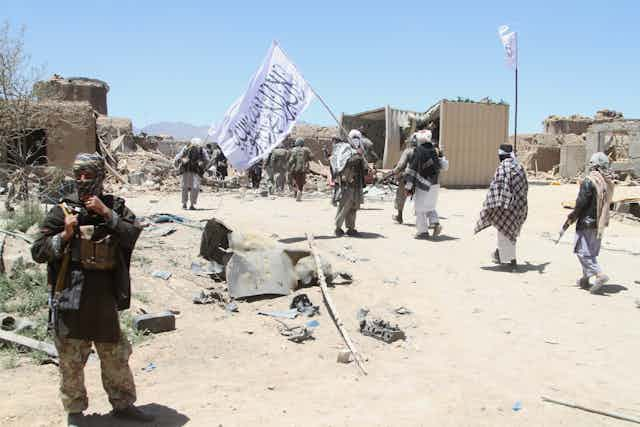Spring in war-ravaged Afghanistan is the season when soldiers, suicide bombers, renegades and warlords emerge from the temporary truce imposed by the bitter winter to face each other once again. This spring has been no different.
In this year’s “spring offensive”, there already have been hundreds of casualties in clashes between government soldiers and Taliban insurgents. At least seven people were killed and more than 119 wounded in three separate explosions at a high-profile funeral in Kabul – the third attack in four days in the Afghan capital. The funeral was for one of several protesters killed days earlier at a large demonstration calling for the resignation of the government after a large truck bomb killed scores of civilians.
Thn there was the horrific massacre by the Taliban of 140 soldiers in a training compound in Mazar-e-Sharif. Added to that have been the numerous everyday attacks on government troops and foreign military across the country. Once dismissed as a lone force, the Taliban is now allied to over ten other terrorist fronts. They are all united by one aim: to demobilise the external forces and oust the national government. All this makes us wonder what is in store for Afghanistan?
While a nervous and helpless Afghan government looks on, there has been a reaction of sorts from NATO – which has been in the country since the ousting of the Taliban regime in 2001. General John Nicholson, the commander of US and NATO forces in Afghanistan, has called for a “few thousand” more troops to break the stalemate in the war with the Taliban. He stressed extra troops were needed to help train the Afghan military. The soldiers, he said, could be American or from other NATO nations.
The Trump administration is also considering a proposal to increase the US troop presence in Afghanistan. But all this begs much bigger questions – is this mad scramble for more troops just a sticking plaster? And is there an actual endgame in sight?
Taliban ‘governance’ and PR
Having been kept out of the political decision-making process, the Taliban is now floating its own system of governance and security. It has specified a “twin-track political and military approach” to what it considers Afghanistan’s current ills. The Taliban has already put in place a programme that focuses on infrastructural development and reconstruction in areas under its control. Interestingly, it seeks to replicate that model across the country by ousting the current government machinery. And it wants to do so by using a well-oiled propaganda machine that stresses the Taliban is there “to help those deceived by the enemy see the truth of its struggle”.

The Taliban has revamped its internal policies and politics. It wants to step away from its earlier mainstream image as a merciless war organism and to appear as a credible alternative to an ineffective and corrupt government in Kabul. It has embraced what one might call a veneer of statecraft. According to US government estimates, by the end of 2016 the government in Kabul had uncontested control of only 57% of the country (a drop from 72% in the 2015). The Taliban, meanwhile, controls nearly a third of Afghanistan.
The Taliban faces a number of opponents – Afghan government soldiers, rival factions and warlords, and the coalition forces from outside. The real the problem for the Taliban, however, is not the indigenous Afghan opposition but the outsiders. It feels it can easily overpower the internal opposition. Any possible challenge to its gameplan, therefore, comes from the coalition forces.
Consequently, it has already made it clear that it will target “foreign forces, their military and intelligence infrastructure”. The Taliban rarely mince their words. Their hideous and merciless offensives often prove their point. The masters of unconventional warfare, their gory terror tactics have not even spared doctors and humanitarian aid workers.
Futility of committing more troops
The UK has been asked by NATO – the alliance of which it is a founding member and pivotal partner – to send more troops into this quagmire. One ought to stress here that a near total British troop withdrawal from Afghanistan took place in 2015.
At the moment, Britain has a small troop presence in Afghanistan, numbering some 500. They offer training facilities to the Afghan National Army and are “deployed to provide security around the capital Kabul”. A large tract of territory that British forces had wrested from the Taliban in the past is now back in Taliban control.
So what is the point of sending new NATO troops to a territory where the conflict is spiralling out of control? Is it worth it? How long can one prevent this rising tide of Taliban offence?
A minuscule troop increase will not make any dent in the strategic crises facing the Afghan state. The Taliban has always considered outside forces as high-value targets and any new additions will be targeted. If the last 16 years of external military engagement is anything to go by, Afghanistan is completely unpredictable and untrustworthy terrain.
Britain has already lost 456 of its brave soldiers to this conflict. If one were to do a realistic audit, the British military engagement in Afghanistan has been a story of one step forward and two steps back. It is time we woke up to the reality. It is time for clear introspection and hard thinking. There needs to be some military pragmatism.
So let us be very clear: Afghanistan is an unwinnable war and Britain cannot go on sacrificing more troops just because it is a committed member of a military alliance.

